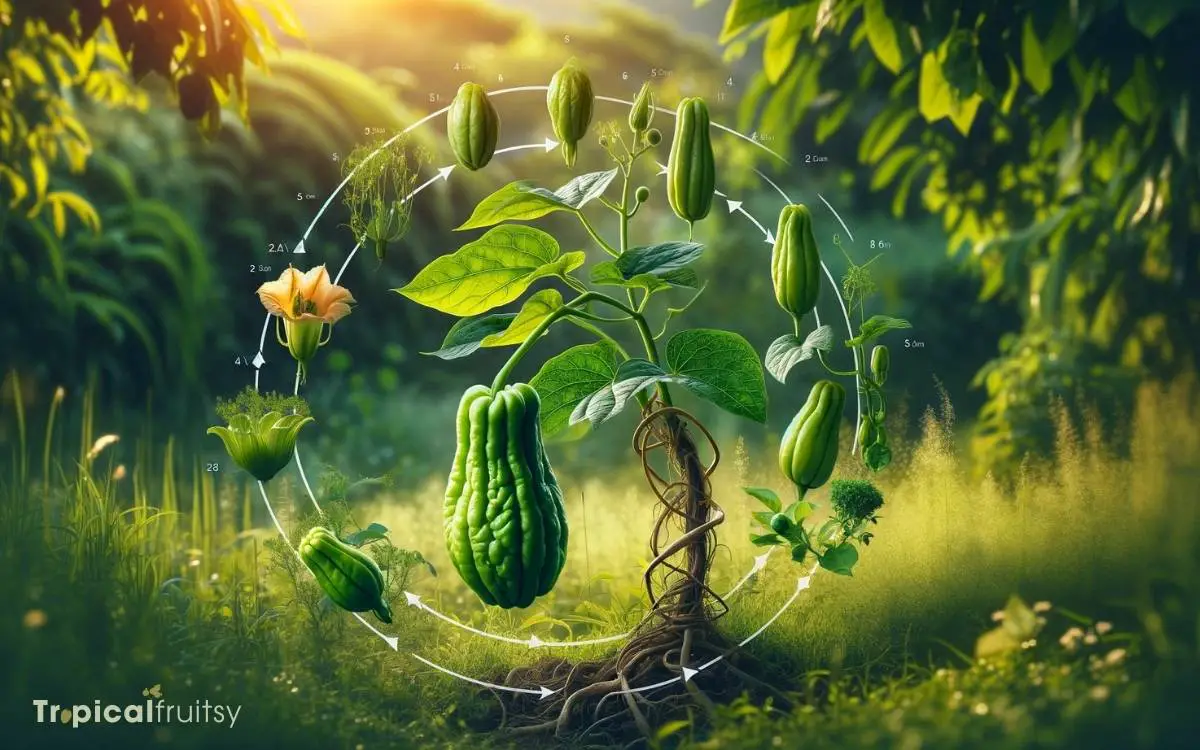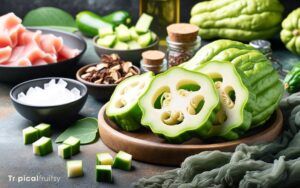How Long Does It Take for Chayote to Bear Fruit? Explore!
Chayote, also known as vegetable pear, typically takes 120 to 150 days to produce fruit after planting. The growth cycle begins with germination, followed by vine development, flowering, and eventually fruiting.
Ideal conditions, including warm climate, ample sunlight, and good soil, are essential for successful cultivation and timely fruiting.
Chayote is a perennial vine that prefers a warm climate and requires a well-draining soil rich in organic matter.
The plant’s growth cycle includes several stages:
Key factors influencing the growth cycle:
A chayote plant in a backyard garden in a subtropical climate, provided with ample sunlight and consistent watering, will successfully bear fruit within the 120-150 day range.
For gardeners looking to grow chayote, patience is key, as the fruiting process reflects a full season’s worth of care and attention to the plant’s needs.

Key Takeaway
Understanding Chayote Growth Cycles
We’ll need to recognize that each chayote plant, once established, typically requires a specific number of months to complete its growth cycle and produce fruit.
Generally, this period spans between 120 to 150 days after planting, when the conditions are optimal.
It’s crucial to understand that chayotes are perennial vines in tropical climates, but they grow as annuals in temperate regions.
The growth cycle’s length can vary based on factors such as climate, soil fertility, and the availability of water and sunlight. We must ensure these elements are well-balanced to optimize the plant’s productivity.
As we grasp the essentials of the chayote’s growth cycle, we’re better prepared to delve into the critical steps of planting and initial care.
Planting and Initial Care Steps
Let’s move on to the vital steps of planting and initial care to ensure our chayote vines thrive and yield fruit successfully.
- First, select a well-draining spot with plenty of sunlight and prepare the soil by incorporating organic matter, which will provide essential nutrients.
- Plant the whole chayote fruit in the ground, with the broader end down, leaving half of it above the surface.
- As chayote plants are climbers, install a sturdy trellis or support system early on.
- They require regular watering, particularly during dry spells, but avoid waterlogging.
- Mulching helps retain soil moisture and suppresses weeds.
- Finally, watch for pests and diseases and address them promptly.
Climatic Impact on Maturation
While we consider the growth cycle of chayote, it’s crucial to understand that the time it takes to bear fruit can significantly vary depending on local climate conditions.
Chayote thrives in warm, frost-free regions with temperatures ranging from 50 to 80°F. When grown in optimal warmth and humidity, chayote plants can mature and produce fruit in roughly 120 to 150 days after planting.
However, it’s important to note that cooler temperatures can slow down the plant’s development, leading to longer maturation times. Excessive heat, on the other hand, may stress the plant, potentially reducing fruit set and quality.
We must monitor local weather patterns and adjust care accordingly to ensure our chayote vines reach their full fruit-bearing potential within a reasonable timeframe.
Recognizing Signs of Fruit Development
Often, we notice the first signs of fruit development in chayote vines when the plants begin to flower, typically a few weeks after the vines have matured.
These indicators are crucial to gauge the progress of your chayote plants and to estimate when you might expect to harvest.
Here’s what we typically look for:
- Flower Emergence: The presence of vibrant flowers is the first clear signal that fruit is on its way.
- Fruit Set: Following pollination, tiny fruits will start to form at the base of the flowers.
- Visible Growth: Over time, these fruits will enlarge, an unmistakable sign that your chayote is developing properly.
Understanding these signs ensures we’re on track to move into the next phase: harvest timing and techniques.
Harvest Timing and Techniques
Once we’ve observed the chayote’s fruits reaching maturity, we’ll need to determine the ideal moment and method for harvesting. It’s crucial to harvest at the right time to ensure the fruits are at their peak for both flavor and nutritional value.
Here’s a quick guide:
| Stage of Maturity | Harvest Technique |
|---|---|
| Slightly firm | Hand-pick gently |
| Full size (4-8 inches) | Cut with sharp knife |
| Light green | Support vine during harvest |
| Matte skin texture | Store at room temperature |
Harvesting should be done carefully to avoid injury to the plant. We’ll cut the stem close to the fruit with a sharp knife, ensuring we don’t damage the vine.
This will encourage further fruiting and maintain the health of the plant. After harvesting, we should store chayote in a cool, dry place to prolong freshness.
Conclusion
We’ve journeyed through the growth of chayote, from planting to harvest. Despite the whims of Mother Nature, typically, our chayote vines will bear fruit within 4 to 5 months.
As we watch for the telltale signs of maturity, we’re ready to employ our best harvest techniques when the time is ripe.
So, let’s grab our sickles—figuratively speaking—and gather the fruits of our labor, relishing the bounty that harkens back to ancient agricultural traditions.






